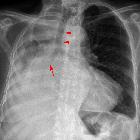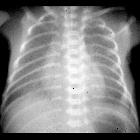round pneumonia














 nicht verwechseln mit: Rundatelektase
nicht verwechseln mit: RundatelektaseRound pneumonia is a type of pneumonia usually only seen in pediatric patients. They are well defined, rounded opacities that represent regions of infected consolidation.
Epidemiology
The mean age of patients with round pneumonia is five years and 90% of patients who present with round pneumonia are younger than twelve . Round pneumonia is uncommon after the age of eight because collateral airways tend to be well developed by this age .
Clinical presentation
Patients present with symptoms of chest infection including fever, sweats, and cough. History of infective symptoms is really helpful when excluding other imaging differentials.
Pathology
The proposed theory as to why children develop round pneumonia and adults do not, relates to the development of inter-alveolar communications and collateral airways. These are called pores of Kohn and canals of Lambert, and when they develop, they allow air-drift between the parenchymal subsegments. In adults, these allow lateral dissemination of infection throughout a lobe, leading to lobar pneumonia. In children, where these have not developed, the limited spread of infection results in round pneumonia .
The infective agent in round pneumonia is bacterial. There is no specific bacterium that causes round pneumonia, but since Streptococcus pneumoniae is the most common cause of chest infection, it is little surprise that it is the leading cause of round pneumonia .
Radiographic features
Plain radiograph
Round pneumonias are round-ish and while they are well-circumscribed parenchymal opacities, they tend to have irregular margins. They most commonly occur in superior segments of lower lobes and in the majority of cases (98%), they are solitary
Air-bronchograms are often present, and helpful in clinching the diagnosis. Interestingly, they are only seen in 17% of cases when they occur in adults .
Treatment and prognosis
If round pneumonia is confidently diagnosed, it does not require further investigation. With antibiotic therapy and resolution of symptoms, it does not require follow up.
If a follow-up radiograph is performed, 95% of cases will have resolved at 30 days. Only a minority of cases (5%) progress to lobar pneumonia .
Differential diagnosis
In children consider
- pulmonary masses
In adults consider
- pulmonary masses
- bronchogenic carcinoma
- pulmonary metastases
- bronchogenic cyst
- pleural fibroma
- fungal infection
- round atelectasis
- radiation pneumonitis
- pulmonary pseudotumor
Related video
Siehe auch:
- Lungenkarzinom
- Bronchogene Zyste
- Pneumonie
- Neuroblastom
- Rundatelektase
- solitärer fibröser Tumor der Pleura
- Lungenmetastasen
- konsolidierte Pneumonie
- Strahlenpneumonitis
- pulmonary pseudotumour
- bakterielle Pneumonien im Kindesalter
- canals of Lambert
- pores of Kohn
- multifokale Rundpneumonie
- type III CCAM
- Air-bronchograms
und weiter:

 Assoziationen und Differentialdiagnosen zu Rundpneumonie:
Assoziationen und Differentialdiagnosen zu Rundpneumonie:









